Corpo Santo
Filipe Castro
Country: Portugal
Place: Lisbon, Largo do Corpo Santo, northern edge of a subway ventilation shaft.
Coordinates: Lat. 38°42’25.80″N; Long. 9° 8’28.05″W
Type: Unknown
Identified: No
Dated: Circa 1400 (C14)
Introduction
This small structure was found in the excavation of a ventilation shaft for the Lisbon Subway, in 1996, laying on a sandy beach, about 1 m above the sea level, under the foundations of a 16th century building. In the 15th century this area – known as Cata-que farás – was contiguous to the shipyards. The remaining preserved hull was unfortunately outside the shaft and is still in situ.
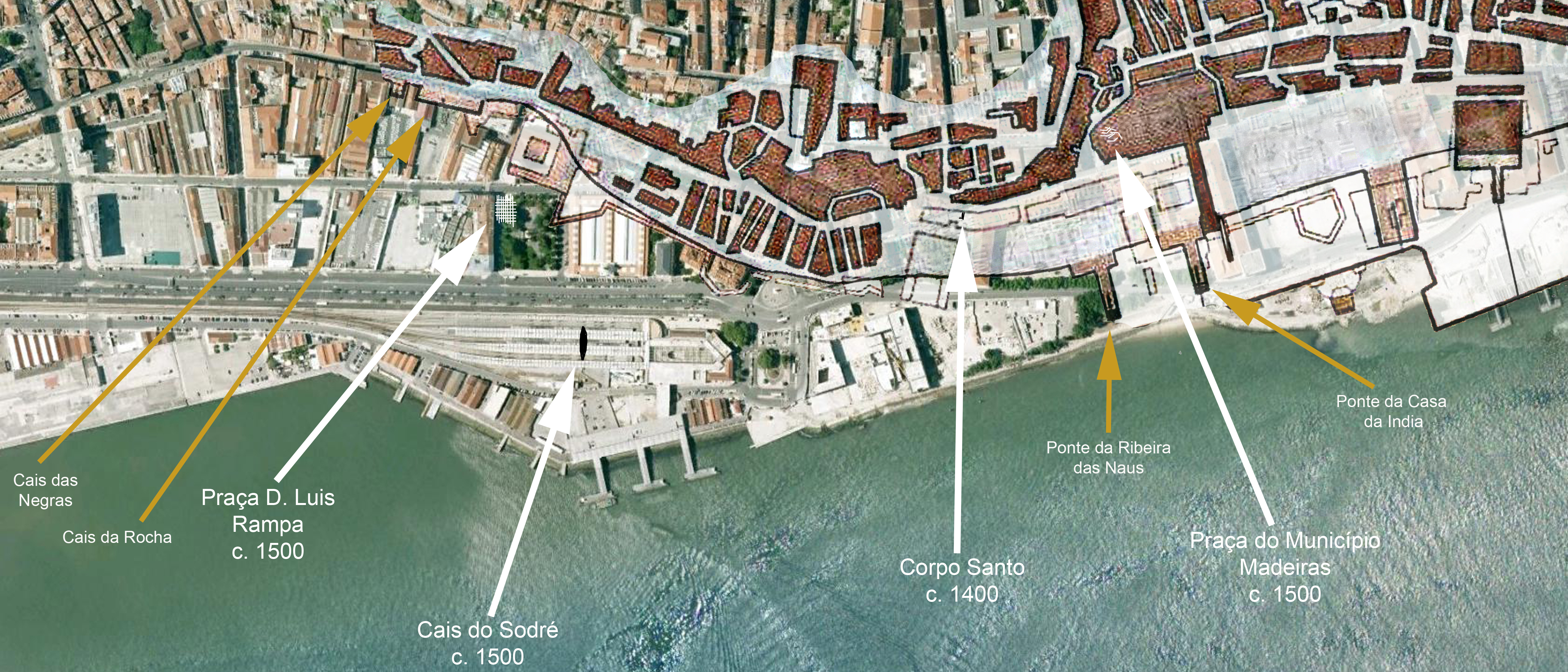
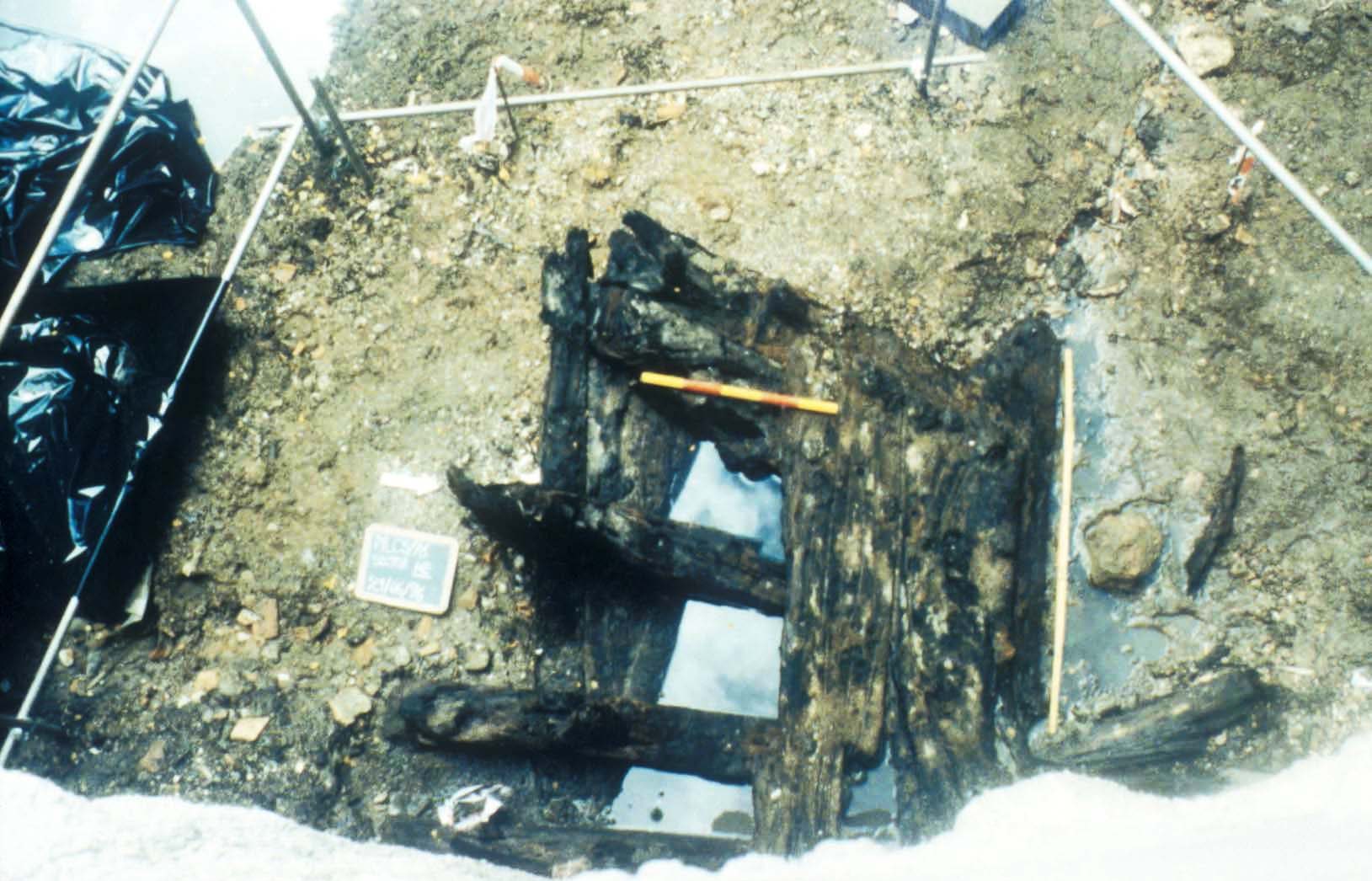
Probably a derelict, no artifacts were associated with these hull remains. The archaeological layers above this shipwreck were littered with 15th and 16th ceramic materials (Alves et al. 2001).
Is was tentatively dated by C14 to 1292-1412 cal AD (2 sigma). there were a few artifacts beneath the hull remains, namely a shoe sole. This ship may have been built in Portugal, since its scantlings suggest a relatively small vessel. It was removed, disassembled, studied, published, and conserved.
Team
This structure was studied by Francisco Alves, Eric Rieth, Paulo Rodrigues, and Miguel Aleluia.
Ballast
If preserved, the central remains of the ship are still buried, outside the excavated shaft.
Anchors
No anchors were found associated with the hull remains.
Guns
No guns were found associated with the hull remains.
Iron Concretions
No iron concretions guns were found associated with the hull remains.
Hull remains
The hull remains consisted of a stern heel, a stern knee, three y-frames and five hull planks. The keel was not preserved but its dimensions (11 cm sided and 13 cm molded) can be inferred from the dimensions of the stern heel.
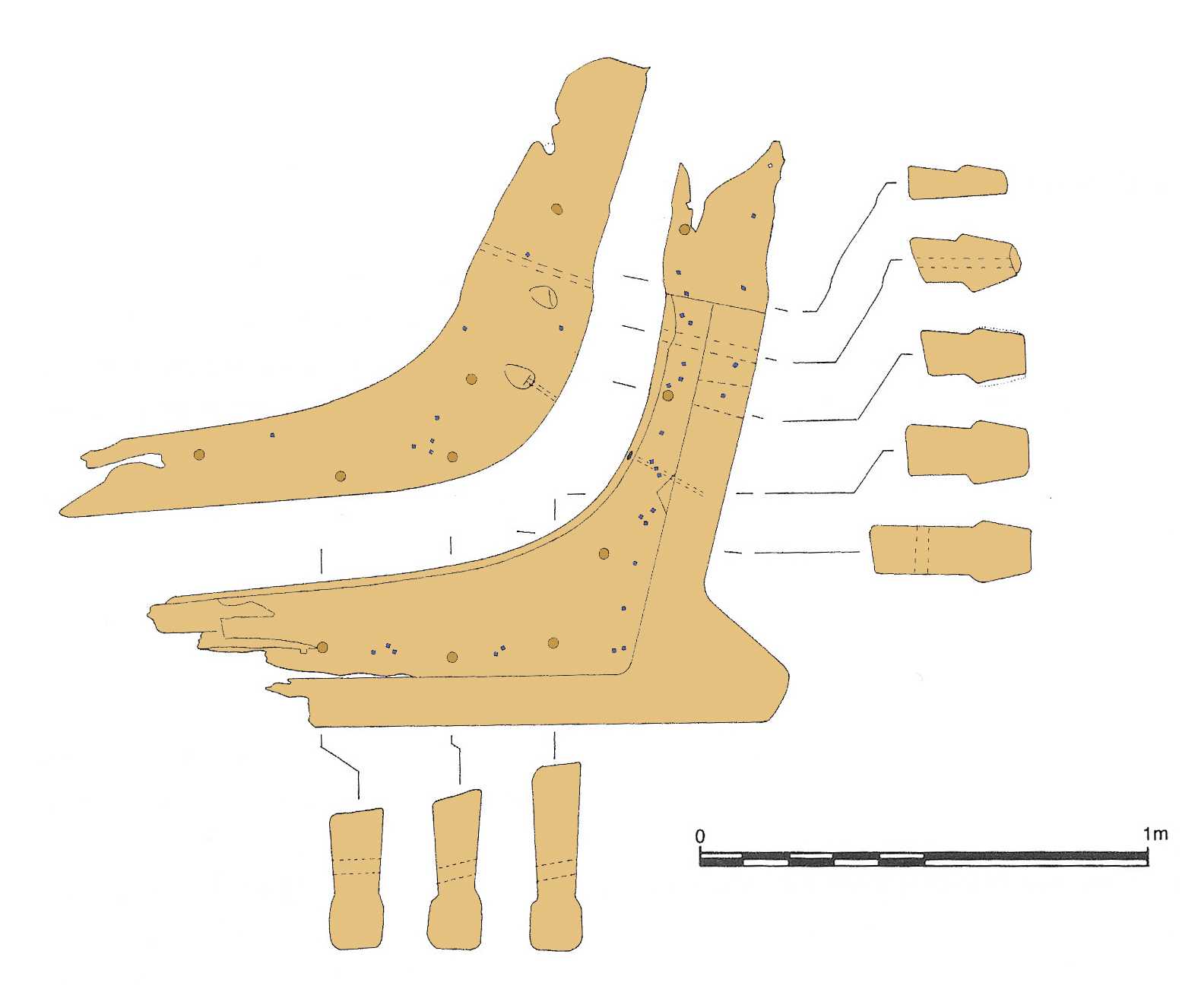
This timber, designated in Portuguese as couce de popa, is characteristic in Portuguese ships and represented in the c. 1600 shipbuilding treatise by João Baptista Lavanha titled Livro primeiro de arquitectura naval (Lavanha 1996).
As the connection between the keel and sternpost is a fragile point in a ship structure, in certain shipbuilding traditions a curved timber was used to address this problem.
An equally characteristic stern knee, in Portuguese coral, was preserved assembled to the stern heel’s upper portion with an iron bolt and a number of iron nails diagonally inserted.
The forward portion of this timber was not preserved, and therefore it is impossible to say how it was fastened to the stern heel.
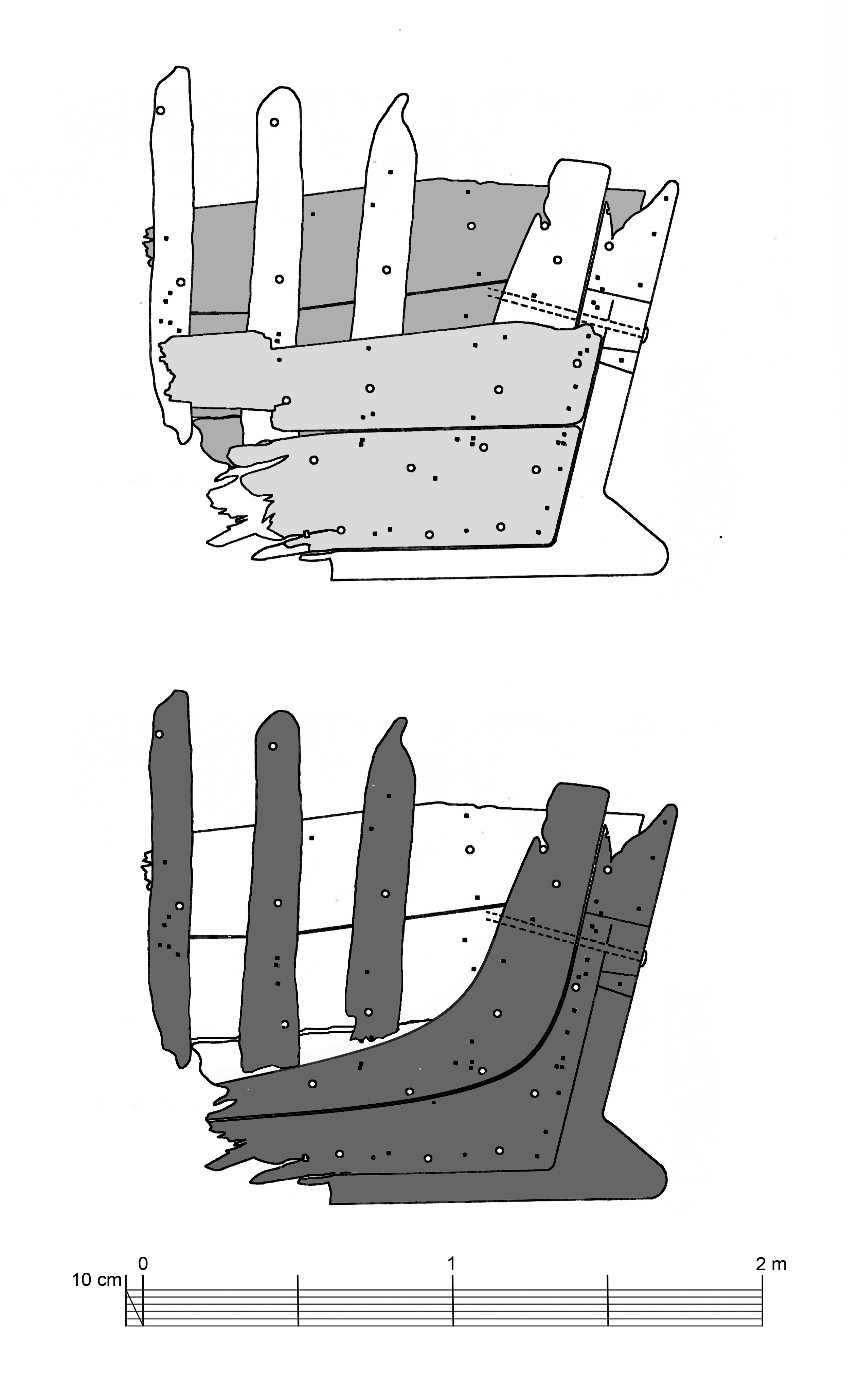
Keel
No keel proper was preserved, although the keel dimensions (11 cm sided and 13 cm molded) can be inferred from the dimensions of the stern heel.
Stern heel (couce)
A characteristic stern heel (couce de popa) was preserved, connecting the keel with the sternpost, which were both lost. A flat scarf connected the heel to the sternpost.
Stern knee (coral)
An inner knee – in Portuguese coral – stood on top of the stern heel, connected to it by a large bolt on the upper portion. The lower portion was not preserved along its entire length. The stern heel presented a characteristic skeg and was preserved 1.4 m along the longitudinal axis, and 1.25 m high, counting from the base of the keel. The sternpost rake was 31°.
There were no tabs carved on the stern knee to receive the y-frames, as it happens in other Iberian shipwrecks.
Frames
Three y-frames were preserved, sitting on the stern knee (coral) and fastened with one nail inserted on a countersink recess on the forward face. These y-frames were 16 cm sided (fore-and-aft) and 12.5-14.5 cm molded (transversal). The room and space is around 32 cm.
Planking
Three rows of planking were preserved on the starboard side and two on the port side. The planks were around 4 cm thick, with widths between 30 and 47 cm. All preserved planks were sawn, almost certainly by hand as suggested by the irregularity of the tool marks, and fastened to the frames and stern timbers with iron nails and treenails.
Table 1. Scantling of the timber remains of the Corpo Santo Shipwreck
| Timber | Sided
[cm] |
Molded
[cm] |
| Keel | 11 | 13 |
| Sternpost | 11 | 13 |
| Floor timbers | 16 | 13.5 |
| Room-and-space | 32 | – |
| Planking | 34 | 4 |
Caulking
Not reported.
Fasteners
All spikes have □ = 1 cm sections, treenails Ø = 2.5 cm, and the iron bold preserved is Ø = 2 cm. The stern heel was bolted to the stern knee with an iron bold and nailed with a series of iron nails diagonally inserted. The floor timbers are fastened to the stern keen with one iron nail. The planking is fasted to the frames with octagonal treenails and iron nails. Being so close to the sternpost, it is impossible to discern a clear pattern.
Size and scantlings
The height of the runs seems to be around 1.5 m, suggesting that the height of the transom might be around 4.5 m, and the ship’s length overall around 15 m.
The only clue to estimate the size of this ship is the height of the runs, which seems to have been around 1.5 m, suggesting that the height of the transom might be around 4.5 m, and the ship’s length overall around 15 m.
Wood
All timbers analyzed were identified as oak (Quercus sp.).
Reconstruction
Beam: Estimated 5 m, based on the probable height of the runs, which was probably 1.5 m.
Keel Length: Estimated 10 m
Length Overall: Estimated 15 m
Number of Masts: Unknown
No reconstruction has been attempted, given the size of the hull remains preserved. Only comparative studies may give us a hint of the ship dimensions, based on the period, tradition, and scantlings recorded.
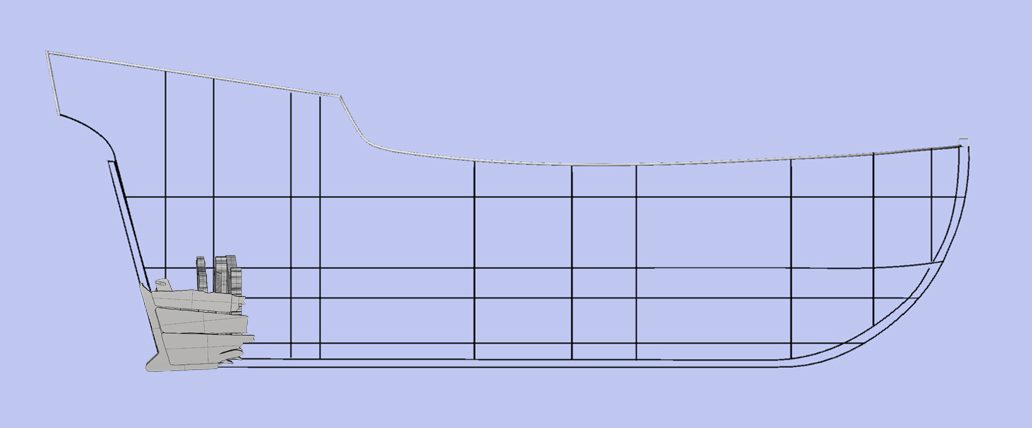
References
Alves, F. and Rodrigues, P. and Rieth, E., 2001. “The remains of a 14th-century shipwreck at Corpo Santo and of a shipyard at Praça do Município, Lisbon, Portugal.” in Alves, F., ed. Proceedings of the International Symposium ‘Archaeology of Medieval and Modern Ships of Iberian-Atlantic Tradition’, Lisbon, September 1998, Lisbon: IPA.
Lavanha, J., 1996. Livro Primeiro de Architectura Naval, circa 1600. Fac-simile, transcription and translation into English, Lisboa: Academia de Marinha.
